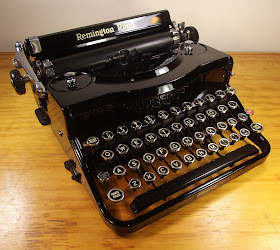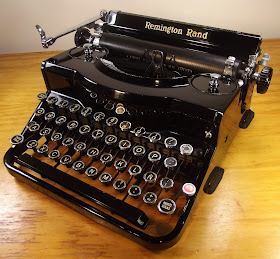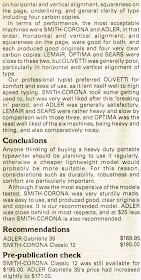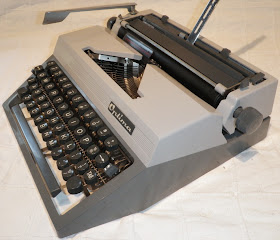Above, the Adler Gabriele 25. The 1978 Choice magazine review of "heavy duty" portable typewriters includes an image of this model, but its report is actually on the Gabriele 35, a somewhat larger model, as can be seen below. Both Adlers are excellent typers which consistently ranked highly in consumer association reports, both in Britain and Australia.
Earlier this year - thanks to John Lambert, of New Haven, Connecticut - we were able to look at the four editions of the British Consumers' Association's Which? magazine which reviewed portable typewriters from 1962 to 1979.
In September 1976, the equivalent Australian consumers' publication, Choice, decided to follow suit and review typewriters available on the Australian market.
The first Australian report was on small electric typewriters, followed in October 1977 by lightweight portables. Finally, in March 1978, Choice reviewed what it called "Heavy Duty Portable Typewriters".
Oddly enough, all six machines Choice subjected to critical analysis in 1978 - the Adler Gabriele 35, Lemair (Brother) 1613 and Sears (Brother) 5262, the Spanish-made Olivetti Studio 46, Optima (Robotron) 41 and the Canadian-made Smith-Corona Classic 12 - had already been included in the lightweight portables review, five months earlier, as was the Citizen X3 (in my book, a "heavy duty" portable).
What's more, the Lemair and Sears machines (1613 and 5262) were the same Brother typewriter, so all up this model was reviewed four times! Brother itself was covered in the lightweight portables issue. Sears typewriters were sold in Australia by Waltons, not Sears. (In the report below, for Lemair and Sears, please read Brother.).
The Gabriele 25 with the Triumph marque.
The Adler Gabriele 35, which presumably is the typewriter covered in the Australian "heavy duty portable typewriters" report, not the Gabriele 25 which it pictured. This model Gabriele 35 was rated "good but pricey" by the British Consumers' Association in its December 1979 issue of Which? magazine.
This earlier version of the Gabriele 25 was the top-ranking typewriter in the 1973 British Consumers' Association report on portable typewriters. Yet again, it is certainly a fantastic typer.
The Smith-Corona Classic 12 (I am showing my own almost identical version above, the Galaxie 12) was, with the Adler Gabriele 35, the typewriter ranked as "recommended" by the Australian Consumers' Association in its Choice magazine report on "Heavy Duty Portable Typewriters" in March 1978.
Florian's Collection
The Brother Deluxe 1613 was reviewed a remarkable four times in five months by the Australian Consumers' Association for its Choice magazine reports on lightweight and heavy duty portable typewriters, in October 1977 and again in March 1978. In each case, it was reviewed not as a Brother, but as a Lemair 1613 (Lemair was a Brother retailer in Australia) and Sears 5262 (the Sears Brother and ABC models were sold by Waltons in Australia, which did not have Sears stores. Waltons had established an alliance with Sears in 1955.). One of these brilliant Brother models, in immaculate condition, attracted only one bid and sold for a mere $19.95 on Australian eBay last night. It seems rather silly of Choice to review the same typewriter twice in two separate issues.
Olivetti Studio 46
Above, the Erika Daro/Optima 41. There were three variations, the Erika/Optima 40, 41 and 42 (with different carriage widths). This typewriter, made by Robotron in East Germany, also sold in Australia as the Hanimex Elite 32 and in Britain as the Boots (through the chemist shop chain). As the Boots, it was reviewed in the British Consumers' Association's magazine Which? in 1973, along with a Smith-Corona Classic 12 variation, the Viceroy Deluxe.
Robotron produced for Erika and Optima (and others, such as Aztec) four basic designs, which Robotron itself classified as the 30-40 (bottom below, aka 14 and E14), 32-42 (above), the 34-44 (aka 50-60, centre below), and the 100-106 (below, confusingly also marketed as a 34).
NEXT: Lightweight Portable Typewriters, Choice, October 1977.


















































